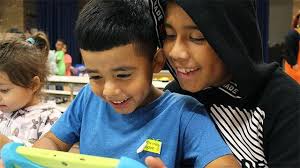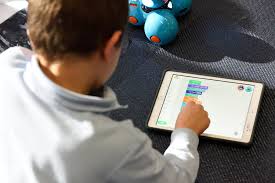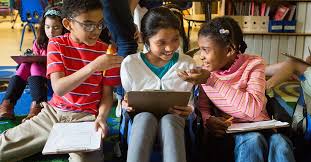What activities help toddlers learn?
8 Learning Activities for Toddlers
- Displaying Her Name.
- Reading Signs.
- Counting Everyday Items.
- Separating Objects by Type or Color.
- Making a Shape Book.
- Teaching Shapes in the Kitchen.
- Finger Painting for Color Recognition.
- Incorporating Colorful Language.
Which game is best for 2 year old?
Top games for 2 year olds
- Acorn Soup. Bean Bag Toss Game.
- First Orchard. Suuuper Size Memory Game.
- Magnetic Toys. Bowling Toy Set.
- Spike the Fine Motor Hedgehog. Scavenger Hunt Cards.
- Coogam Wooden Magnetic Fishing Game. ThinkFun Roll and Play.
- Peaceable Kingdom Where’s Bear? Peaceable Kingdom Monkey Around.
What games can you play with 2 year old?
10 fun games to play with toddlers
- Simon Says. A game that you can play one on one or with a group of kids, Simon Says is a classic that teaches kids how to follow instructions.
- Hot and cold. See his favourite stuffy over there?
- One for you, one for me.
- Hokey-Pokey.
- Parachute.
- Scavenger hunt.
- Hide-and-seek.
- Obstacle course.
What is free play for toddlers? Free play is when children have full freedom to play in whatever way they want. “They can choose everything – they have the freedom to select their play materials, interest area and even the plot,” explains Zaman.
What activities help toddlers learn? – Additional Questions
How do I entertain my toddler all day?
5 Things I Do Every Day With My Toddler
- Read. This is the most obvious, but probably the most important.
- Go on a hunt. If you have been a follower of Toddler Approved for awhile then you know we love to go on hunts!
- Play with playdough.
- Move.
- Pretend Play.
Is it OK to let toddler play alone?
Rest assured, it’s perfectly okay to let your child play alone, even at a young age, as long as you’re nearby and he’s safe. So if your little one is looking at a book in his crib or sitting on the floor stacking cups (within ear- and eyeshot, of course), leave him be.
What is an example of free play?
Free play is any kind of play that is initiated by a child. Outdoor play and indoor play can both be considered free play, as long as your child has the freedom to control their own play experience. There are two types of play activities – adult-guided play and child-directed play.
What is considered free play?
What is Free Play? Free play is unstructured, voluntary, child-initiated activity that allows children to develop their imaginations while exploring and experiencing the world around them.1 It is the spontaneous play that comes naturally from children’s natural curiosity, love of discovery, and enthusiasm.2.
What are the overall benefits of free play for the child?
Free Play Reinforces Classroom Learning
We know from studies that Free Play is important to for healthy brain development, allowing children to use their creativity while developing their imagination, dexterity, cognitive and physical abilities. Free Play is a tool for developing a child as a whole.
What does free flow play mean?
What is Free Flow Play? Free Flow Play is used with children in early years settings and allows children to move freely indoors and outdoors however they please. Encourage by the EYFS (Early Years Foundation Stage) framework, free flow play is said to provide a richer learning environment for young children.
What is structured play for toddlers?
What Is Structured Play? Structured play is a term used to refer to a goal-oriented activity. Examples of structured play include board games, outdoor games like tag, organized sports such as soccer or anything else that requires a child to follow directions to complete something.
What does child led play mean?
Child-led play means following your child’s lead in play. It means watching your child and responding to what your child says or does to keep their attention focused a little bit longer. Following your child’s lead is good because your child learns best when they’re interested in an activity.
What is Tina Bruce’s play theory?
Bruce believes that play is an active process rather than something that reaches a goal or produces a product, and that providing toys is not necessary because children can come up with their own props using simple materials such as sticks and pebbles.
What is Susan Isaacs play theory?
Isaacs used her psychoanalytical knowledge to underpin her understanding of the role of play in a child’s development. She explained that children’s play was a form of self-expression that enabled them both to release their real feelings safely and to rehearse ways of dealing with a range of emotions.
What is Sara Smilansky’s theory?
Smilansky and Shefatya said that functional play is “based on children’s need to activate his physical organism”. Conditional play starts around early childhood and lasts until adulthood and involves sensorimotor activities, where children begin using their creativity.
What is the Montessori theory?
The Montessori method of education, named after its founder Maria Montessori, is an approach to classroom learning that emphasizes independence and choice. This theory of teaching understands that children have an innate interest to learn and will be able to do so in a suitable environment.
What are the 5 principles of Montessori?
The Five Principles
- Principle 1: Respect for the Child. Respect for the Child is the major principle underlying the entire Montessori method.
- Principle 2: The Absorbent Mind.
- Principle 3: Sensitive Periods.
- Principle 4: The Prepared Environment.
- Principle 5: Auto education.
How can I start Montessori at home?
Start with building a Montessori lifestyle: explore, respect the child, follow the child’s interests, slow down, involve them in your everyday work, and give them sensory experiences. Then, begin to add basic Montessori activities with materials at home, like practical life and sensory activities. Read lots of books.
What is a Montessori toy?
What is a Montessori Toy? A Montessori toy is one that stimulates learning by encouraging kids to experiment. It should be a toy that they can hold and touch, as learning to manipulate objects is key in helping children develop their fine motor skills.
Why is Montessori not colorful?
Montessori at home doesn’t restrict color; it reminds us not to restrict natural beauty. It is more often the case that color is used to overstimulate and distract the child.
What are the disadvantages of Montessori?
More Cons of the Montessori Method
- It can minimize the importance of friendships.
- It can be difficult to adapt to other types of school.
- Not every community has a Montessori school.
- It requires a student to learn self-motivation to be successful.
- Any school can claim to be a Montessori school.




